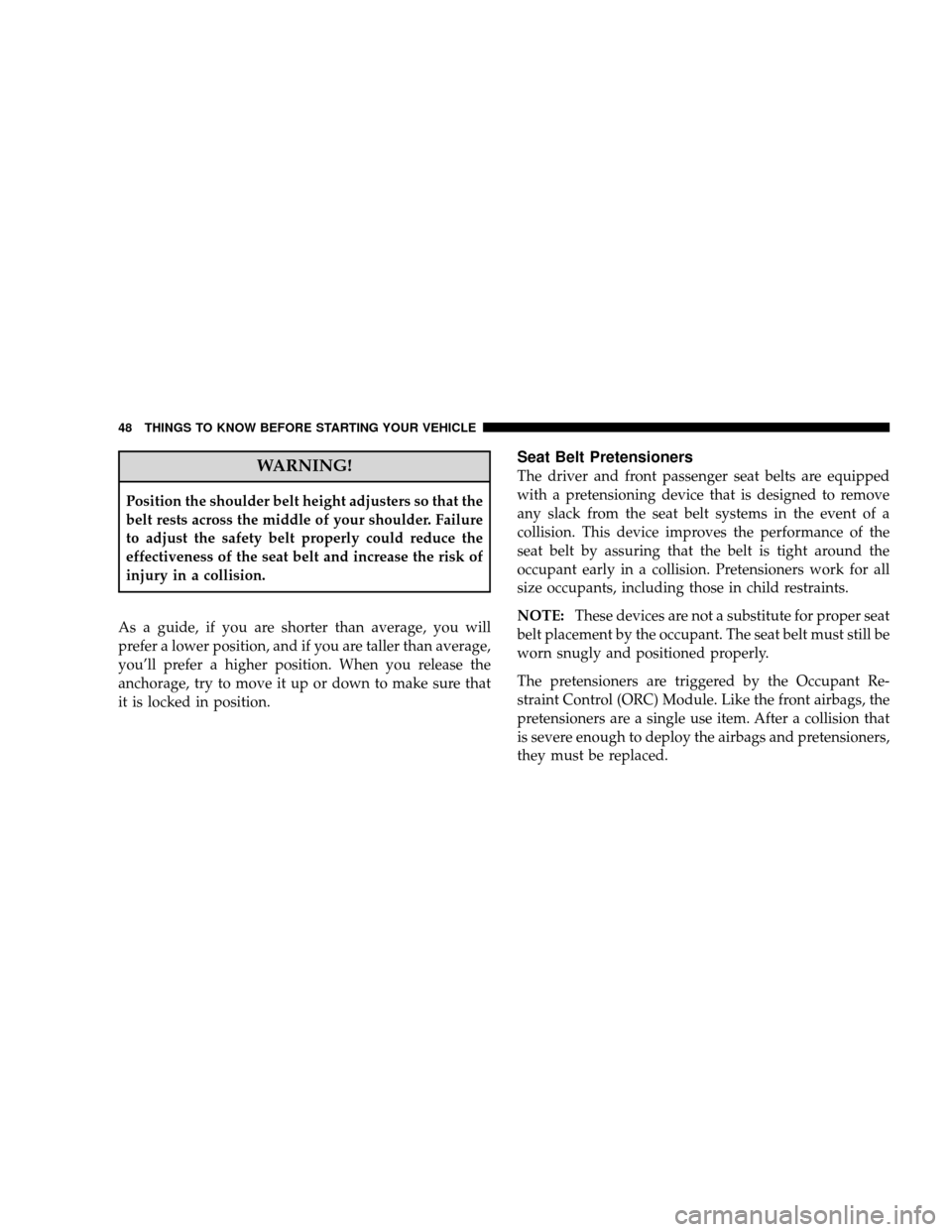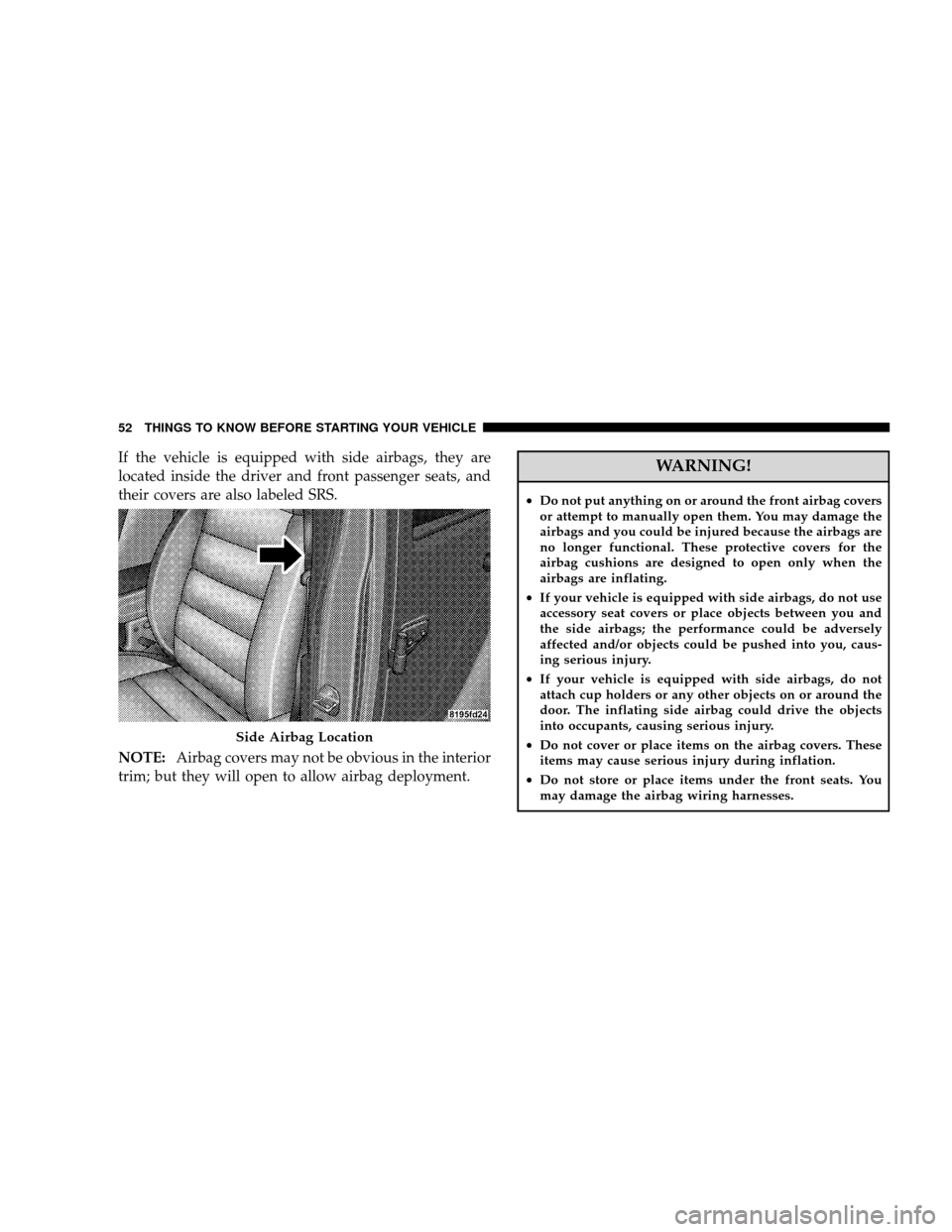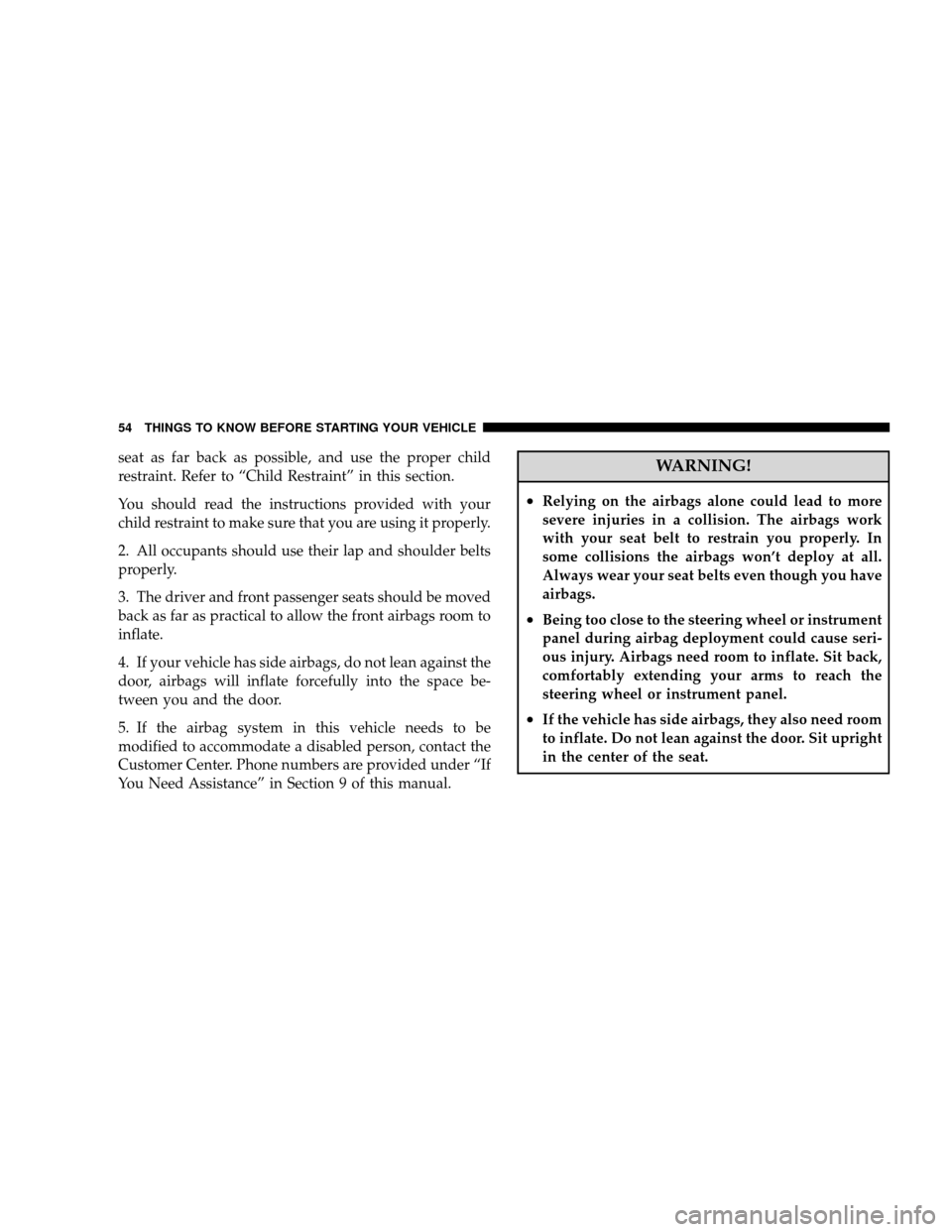Page 46 of 466
WARNING!
A lap belt worn too high can increase the risk of
internal injury in a collision. The belt forces won’t be
at the strong hip and pelvic bones, but across your
abdomen. Always wear the lap belt as low as pos-
sible and keep it snug.
A twisted belt cannot do its job as well. In a collision
it could even cut into you. Be sure the belt is straight.
If you cannot straighten a belt in your vehicle, take it
to your authorized dealer and have it fixed.
5. Position the shoulder belt on your chest so that it is
comfortable and not resting on your neck. The retractor
will withdraw any slack in the belt.
Removing Slack From Belt
THINGS TO KNOW BEFORE STARTING YOUR VEHICLE 45
2
Page 47 of 466

6. To release the belt, push the red button on the buckle.
The belt will automatically retract to its stowed position.
If necessary, slide the latch plate down the webbing to
allow the belt to retract fully.
WARNING!
A frayed or torn belt could rip apart in a collision and
leave you with no protection. Inspect the belt system
periodically, checking for cuts, frays, or loose parts.
Damaged parts must be replaced immediately. Do
not disassemble or modify the system. Seat belt
assemblies must be replaced after a collision if they
have been damaged (bent retractor, torn webbing,
etc.).
Rear Center Lap/Shoulder Belt Retractor
Lock-Out (Four-Door Models Only)
This feature is designed to lock the retractor whenever
the 60% rear seatback is not fully latched. This prevents
someone from wearing the rear center lap/shoulder belt
when the rear seatback is not fully latched.
NOTE:
•If the rear center lap/shoulder belt cannot be pulled
out, check that the rear seatback is fully latched.
•If the rear seatback is properly latched and the rear
center lap/shoulder belt still cannot be pulled out, the
Automatic-Locking Retractor (ALR) system may be
activated. To reset this feature you must let all of the
belt webbing return into the retractor. You will not be
able to pull out more webbing until all of the webbing
has been returned back into the retractor.
46 THINGS TO KNOW BEFORE STARTING YOUR VEHICLE
Page 48 of 466
WARNING!
The rear center lap/shoulder belt is equipped with a
lock-out feature to ensure that the rear seatback is in
the fully upright and locked position when occupied.
If the rear seatback is not fully upright and locked
and the rear center lap/shoulder belt can be pulled
out of the retractor, the vehicle should immediately
be taken to your authorized dealer for service. Failure
to follow this warning could result in serious or fatal
injury.
Adjustable Upper Shoulder Belt Anchorage
In the front seat positions, the shoulder belt anchorage
can be adjusted upward or downward to position the belt
away from your neck. Push in on the anchorage near
your outside shoulder and slide it up or down to reach
the position that serves you best.
Adjusting Upper Shoulder Belt
THINGS TO KNOW BEFORE STARTING YOUR VEHICLE 47
2
Page 49 of 466

WARNING!
Position the shoulder belt height adjusters so that the
belt rests across the middle of your shoulder. Failure
to adjust the safety belt properly could reduce the
effectiveness of the seat belt and increase the risk of
injury in a collision.
As a guide, if you are shorter than average, you will
prefer a lower position, and if you are taller than average,
you’ll prefer a higher position. When you release the
anchorage, try to move it up or down to make sure that
it is locked in position.
Seat Belt Pretensioners
The driver and front passenger seat belts are equipped
with a pretensioning device that is designed to remove
any slack from the seat belt systems in the event of a
collision. This device improves the performance of the
seat belt by assuring that the belt is tight around the
occupant early in a collision. Pretensioners work for all
size occupants, including those in child restraints.
NOTE: These devices are not a substitute for proper seat
belt placement by the occupant. The seat belt must still be
worn snugly and positioned properly.
The pretensioners are triggered by the Occupant Re-
straint Control (ORC) Module. Like the front airbags, the
pretensioners are a single use item. After a collision that
is severe enough to deploy the airbags and pretensioners,
they must be replaced.
48 THINGS TO KNOW BEFORE STARTING YOUR VEHICLE
Page 50 of 466

Enhanced Seat Belt Use Reminder System
(BeltAlert�)
If the driver’s seat belt has not been buckled within 60
seconds of starting the vehicle and if the vehicle speed is
greater than 5 mph (8 km/h), the Enhanced Warning
System (BeltAlert�) will alert the driver to buckle the seat
belt. The driver should also instruct all other occupants to
buckle their seat belts. Once the warning is triggered, the
Enhanced Warning System (BeltAlert�) will continue to
chime and flash the Seat Belt Warning Light for 96
seconds or until the driver’s seat belt is buckled.
The Enhanced Warning System (BeltAlert�) will be reac-
tivated if the driver’s seat belt is unbuckled for more than
10 seconds and the vehicle speed is greater than 5 mph (8
km/h).
The Enhanced Warning System (BeltAlert�) can be en-
abled or disabled by your authorized dealer or by
following these steps:NOTE:
The following steps must occur within the first
60 seconds of the ignition switch being turned to the ON
or START position. The manufacturer does not recom-
mend deactivating the Enhanced Warning System
(BeltAlert�).
1. Turn the ignition switch to the OFF position, and
buckle the driver’s seat belt.
2. Turn the ignition key to the ACC/RUN position
(engine does not need to be running), and wait for the
Seat Belt Warning Light to turn off.
3. Within 60 seconds of starting the vehicle, unbuckle
and then re-buckle the driver’s seat belt at least three
times within 10 seconds, ending with the seat belt
buckled.
4. Turn the ignition key to the OFF position. A single
chime will sound to signify that you have successfully
completed the programming.
THINGS TO KNOW BEFORE STARTING YOUR VEHICLE 49
2
Page 51 of 466

The Enhanced Warning System (BeltAlert�) can be reac-
tivated by repeating this procedure.
NOTE:Although the Enhanced Warning System
(BeltAlert�) has been deactivated, the Seat Belt Warning
Light will continue to illuminate while the driver’s seat
belt remains unfastened.
Seat Belts And Pregnant Women
We recommend that pregnant women use seat belts
throughout their pregnancy. Keeping the mother safe is
the best way to keep the baby safe.
Pregnant women should wear the lap part of the belt
across the thighs and as snug across the hips as possible.
Keep the belt low so that it does not come across the
abdomen. That way the strong bones of the hips will take
the force if there is a collision.
Seat Belt Extender
If a seat belt is too short, even when fully extended and
when the adjustable upper shoulder belt anchorage (if
equipped) is in its lowest position, your authorized
dealer can provide you with a seat belt extender. This
extender should be used only if the existing belt is not
long enough. When it is not required, remove the ex-
tender and store it.
WARNING!
Using a seat belt extender when not needed can
increase the risk of injury in a collision. Only use
when the seat belt is not long enough when it is worn
low and snug, and in the recommended seating
positions. Remove and stow the seat belt extender
when not needed.
50 THINGS TO KNOW BEFORE STARTING YOUR VEHICLE
Page 53 of 466

If the vehicle is equipped with side airbags, they are
located inside the driver and front passenger seats, and
their covers are also labeled SRS.
NOTE:Airbag covers may not be obvious in the interior
trim; but they will open to allow airbag deployment.WARNING!
• Do not put anything on or around the front airbag covers
or attempt to manually open them. You may damage the
airbags and you could be injured because the airbags are
no longer functional. These protective covers for the
airbag cushions are designed to open only when the
airbags are inflating.
• If your vehicle is equipped with side airbags, do not use
accessory seat covers or place objects between you and
the side airbags; the performance could be adversely
affected and/or objects could be pushed into you, caus-
ing serious injury.
• If your vehicle is equipped with side airbags, do not
attach cup holders or any other objects on or around the
door. The inflating side airbag could drive the objects
into occupants, causing serious injury.
• Do not cover or place items on the airbag covers. These
items may cause serious injury during inflation.
• Do not store or place items under the front seats. You
may damage the airbag wiring harnesses.
Side Airbag Location
52 THINGS TO KNOW BEFORE STARTING YOUR VEHICLE
Page 55 of 466

seat as far back as possible, and use the proper child
restraint. Refer to “Child Restraint” in this section.
You should read the instructions provided with your
child restraint to make sure that you are using it properly.
2. All occupants should use their lap and shoulder belts
properly.
3. The driver and front passenger seats should be moved
back as far as practical to allow the front airbags room to
inflate.
4. If your vehicle has side airbags, do not lean against the
door, airbags will inflate forcefully into the space be-
tween you and the door.
5. If the airbag system in this vehicle needs to be
modified to accommodate a disabled person, contact the
Customer Center. Phone numbers are provided under “If
You Need Assistance” in Section 9 of this manual.WARNING!
•Relying on the airbags alone could lead to more
severe injuries in a collision. The airbags work
with your seat belt to restrain you properly. In
some collisions the airbags won’t deploy at all.
Always wear your seat belts even though you have
airbags.
•Being too close to the steering wheel or instrument
panel during airbag deployment could cause seri-
ous injury. Airbags need room to inflate. Sit back,
comfortably extending your arms to reach the
steering wheel or instrument panel.
•If the vehicle has side airbags, they also need room
to inflate. Do not lean against the door. Sit upright
in the center of the seat.
54 THINGS TO KNOW BEFORE STARTING YOUR VEHICLE